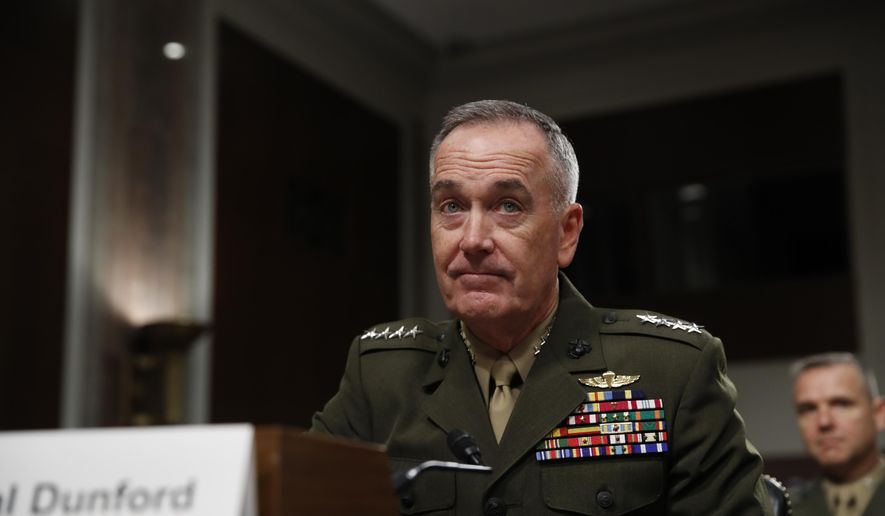WASHINGTON (AP) - The U.S. shoots down a Syrian fighter jet for the first time. Syria attacks America’s allies against Islamic State militants. Iran fires missiles into Syria. Russia threatens to target U.S. coalition planes.
As Syria’s complex war ramps up, the Trump administration is scrambling to tamp down tensions and avoid open hostilities with the Russians.
This weekend’s fast-paced developments bring new urgency to easing escalating strains between Washington and Moscow, who are both fighting in Syria but with opposing objectives. It’s an effort made more complicated by the increasingly messy battlefield in the Arab country, which includes deepening Iranian involvement - its first missile foray into Syria occurred Sunday - and an ongoing probe in the United States into Russian meddling in the presidential election.
In the first high-level U.S. public comments about the situation, Marine Gen. Joseph Dunford, chairman of the Joint Chiefs of Staff, said Monday the former Cold War foes are in delicate discussions to restore normalcy to communications and maintain focus on fighting IS instead of each other.
“The worst thing any of us could do right now is address this with hyperbole,” Dunford said at the National Press Club.
Throughout Syria’s six-and-a-half year civil war, the United States has supported rebels opposed to President Bashar Assad’s government and extremist groups like IS, while Russia has backed Assad. And that disagreement has constrained American leaders, who’ve made clear that any U.S. military activity in Syria avoid provoking an open confrontation between the U.S. and Russia, the world’s two greatest nuclear powers.
At the White House, spokesman Sean Spicer said: “It’s important and crucial that we keep lines of communication open to deconflict potential issues.” The U.S. and Russia use the term “deconfliction” for discussions to prevent mishaps between their planes flying in Syria’s skies.
But in a warning that the U.S. would protect its partners, Spicer said: “The Syrian regime and others in the region need to understand that we will retain the right of self-defense of coalition forces aligned against ISIS.”
Tensions rose Sunday as the U.S. shot down a Syrian Air Force SU-22 fighter that U.S. officials said had bombed American-backed Syrian fighters involved in an emerging battle to recapture the Islamic State’s self-declared capital of Raqqa. The U.S.-led coalition said it acted in “collective self-defense” of partnered forces. Russia called it a “cynical” violation of the Arab country’s sovereignty.
Russia said its warplanes were flying over Syria at the time of the shootdown and the U.S. failed to use the existing deconfliction channel between U.S. military officers at al-Udeid air base in Qatar and Russian officers at Hemeimeem air base.
“We view these actions by the U.S. military as a deliberate failure to heed its obligations,” the Defense Ministry said, adding that it was immediately suspending cooperation under an October 2015 agreement to ensure safe air operations over Syria. It also issued what appeared a threat to target U.S. coalition aircraft flying west of the Euphrates River.
Dunford seemed unperturbed.
“I’m confident that we are still communicating,” he said, adding: “I’m also confident that our forces have the capability to take care of themselves.”
The immediate effect on the U.S.-led campaign against IS is unclear. Coalition aircraft will continue flying throughout Syria, although some assets will be repositioned, said Col. Ryan Dillon, a coalition spokesman.
“We are going to make sure that we have the right aircraft in the right places,” he said, noting that some aircraft may have to avoid “high-threat” areas.
The U.S. and its coalition partners fly combat and support missions daily out of several bases in the Middle East, including in Qatar and Turkey. The flights support Syrian Arab and Kurdish fighters aligned against Islamic State militants. The U.S. also has about 1,000 troops on the ground in Syria advising local fighters.
Russia has fighter aircraft, air defense weapons and other military assets in Syria in support of President Bashar Assad’s government. Moscow has said it entered the fight mainly to combat IS. “We’ll see if that’s true here in the coming hours,” Dunford said.
Syria’s latest developments add significance to talks set for Friday in St Petersburg between senior U.S. and Russian diplomats meant to focus on key differences in the relationship, such as Syria and Ukraine. Tom Shannon, the State Department No. 3, will meet Sergei Ryabkov, Russia’s deputy foreign minister.
“The Russians clearly are doing a lot of sabre rattling right now, but the reality is that the United States has significantly superior air power in the region, and it would be extremely foolish for the Russians to pick a fight with the United States in Syria,” said Nile Gardiner, an international affairs expert at the Heritage Foundation think tank. “The balance of power in Syria is shifting away from Moscow and you are having a more assertive U.S. presence in the region.”
___
Associated Press writer Lolita C. Baldor in Washington and Vladimir Isachenkov in Moscow contributed to this report.




Please read our comment policy before commenting.